Frequently overshadowed by tourist titan Bali to the east and mega-city Jakarta to the west, central Java’s charming historic city of Yogyakarta is truly one of Indonesia’s must-visit travel gems. The Expat Group editor Chad Merchant takes another trip to this fascinating cradle of Javanese history, archaeology, culture, and cuisine, all played out in the shadow of Indonesia’s most active volcano.
Roughly a thousand years ago, central Java was the dominion of the Mataram Kingdom, which thrived under the Sailiendra dynasty, and which, for its time, was quite advanced. Both prosperous and civilised, it was this kingdom, under the reign of King Samaratungga, which built the magnificent Borobudur temple, a sprawling complex which was, at the time of its construction in the 9th century, the largest Buddhist temple in the world.
Today, Borobudur, as a UNESCO World Heritage Site (and Indonesia’s single most-visited tourist attraction), continues to draw visitors from near and far to this region, but if you see nothing of Yogyakarta – called Jogja by locals – while marvelling at the stupas of Borobudur, you will have missed the inimitable charms of one of Indonesia’s most enjoyable cities.
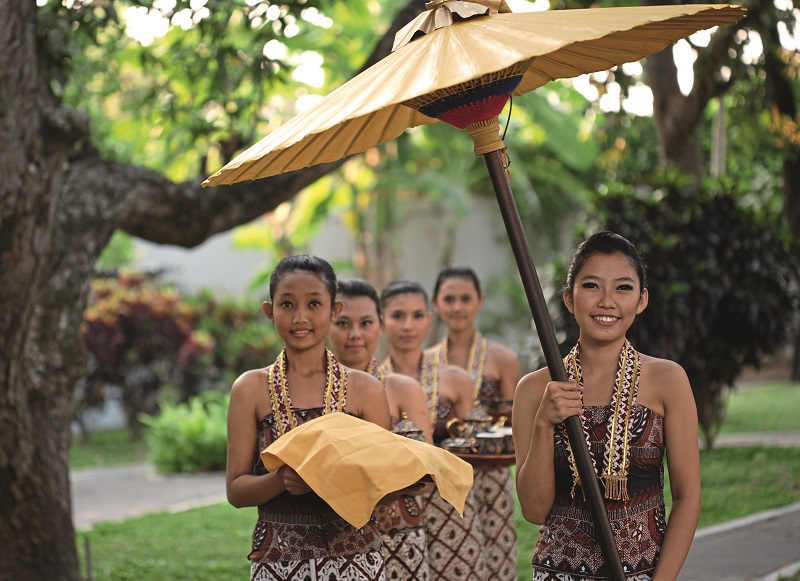
Indeed, some of my fondest memories of my many trips to Indonesia were forged along the streets and alleys of Jogja, so I was quite keen to return as soon as Indonesia surprisingly expanded its visa exemption program earlier in 2016. The appeal of Jogja is multifaceted: its people are as kind and open as you’d ever want to meet, the food is fantastic and authentic Javanese, and if Bali’s soaring tourist prices have left you breathless, Jogja has the cure for what ails you: this fascinating city is still one of the cheapest tourist destinations in the region… a budget traveller can get by in reasonable comfort on RM 100 per day.
Always some of the best values in the region, the accommodations in Jogja have improved considerably in seven years since my last visit and now cover the range from clean, comfy budget rooms for RM 30-40 per night to international-standard boutique villas and posh hotel suites for about RM 250-350. Numerous good-quality hotel rooms can be found in the RM 120-250 range.Whatever your budget, you will find excellent value for money in Jogja. This time around, I stayed at the beautiful and interesting Royal Ambarrukmo hotel. The heritage property was extensively refurbished in 2011 to five-star standards and is sited on the royal grounds owned by the Sultan.
Rooms and suites are modern and comfortable, boasting spacious balconies as well, with views of the gardens, the surrounding cityscape, and Mount Merapi to the north. There’s plenty to feast your eyes on in the hotel itself, too – stunning mosaic murals, stone carvings, a large garden area with walking paths and numerous copper sculptures, and the historic bale kambang, a recreational bathing pool and meditation facility for the King and Royal Family. Adjacent to the hotel and its royal gardens stands the Kedaton Ambarrukmo, the Royal Palace Residence which was built in 1857 by King Hamengkubuwono VI.
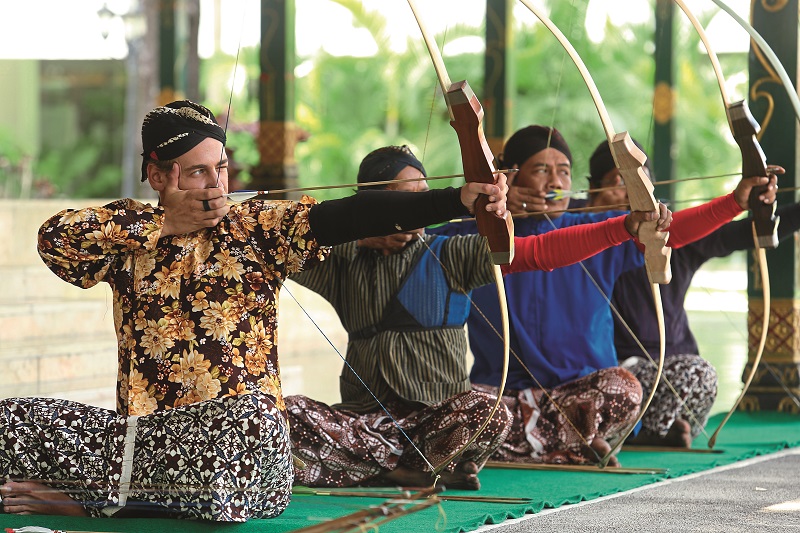
Late in the 19th century, the residence was renovated and functioned as a meeting and function venue for the succeeding king. Today, the entire structure is registered as a National Heritage Site and houses a museum and gallery. The venue is still used by royalty and part of the former residence has been revamped and functions today as the hotel’s Nurkadhatyan Spa. One of the fascinating pursuits taking place weekly on the grounds is jemparingan, or Javanese archery.
Rather different in some respects from what you may know from its Western counterpart, the traditionally clothed archers are seated, and the target is a tiny soft cylinder with a red “head” mounted on a vertical rope, some 30 metres away. The marksmanship is astounding and getting to watch this traditional Javanese pursuit was a real treat. (To learn more about this fascinating sport, visit atarn.org/Indonesian/indonesian_archery.htm.)
Next door to the hotel grounds is the upmarket Plaza Ambarrukmo shopping mall, now celebrating its 10th anniversary, and apart from the mall, found nearby are a number of shops and roadside warungs, the nightly pop-up-style eateries serving delicious Javanese food on the cheap, cooked fresh to order, and served, naturally, with a complete absence of ambiance. Of course, dining at the Royal Ambarrukmo hotel is also an option. On weekends, a lavish buffet of local cuisine is offered for a scant Rp. 120,000 nett, which is currently less than US$10. They feature live gamelan music, the food is superb, and it’s a good opportunity to try a broad range of Javanese and Jogjanese cooking.
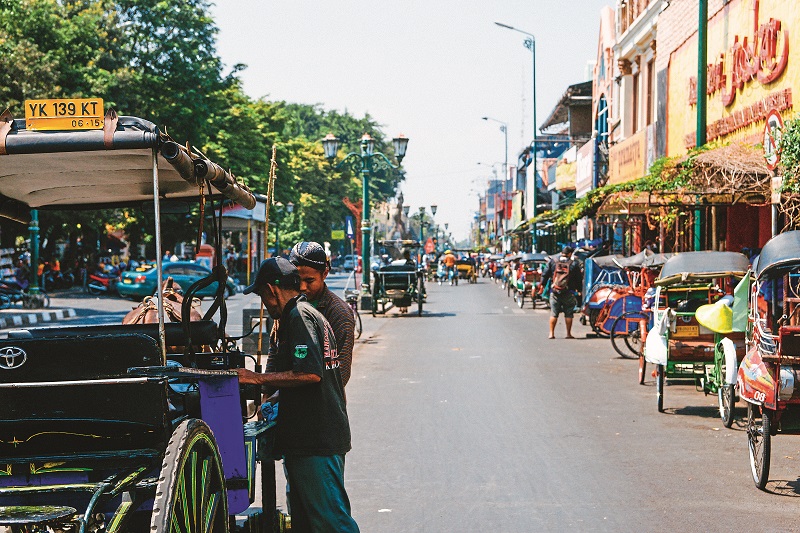
Getting around town is easy when staying at Royal Ambarrukmo, too. In addition to the numerous taxis plying the main road, the hotel maintains an easy-to-book transport service in a range of vehicles at surprisingly affordable rates for its in-house guests. As an example, a five-hour car hire, with driver, starts at just Rp. 500,000, or about US$38. For longer journeys around the region, full-day hires start at only Rp. 800,000, or roughly US$60. Full tour packages are also available.
Malioboro, the Heart of Jogja
If you talk to anyone who’s been to Jogja and ask what they most remember, they’ll likely mention Jalan Malioboro, a not-to-be-missed stop on the tourist circuit in Jogja. Filled from one end to the other with a bewildering array of vendors, shops, and – naturally – a few touts here and there, this is the place to go for shoppers, bargain-hunters, and those who enjoy a bit of friendly haggling.
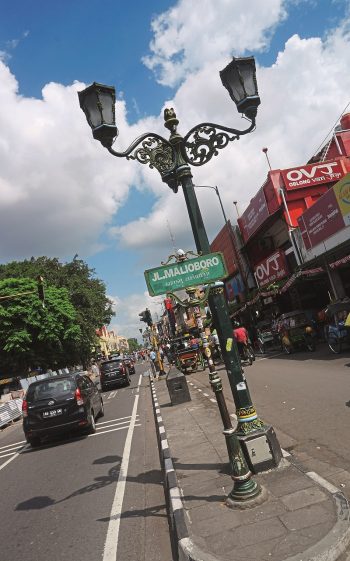
Tourists will, naturally, never get the rock-bottom prices locals do, but that’s okay, because if your skills are finely honed enough, you’ll still walk off with that coveted batik scarf, wood carving, or oil painting at a very attractive price. On this trip, some construction was taking place along the road, so it seems Jalan Malioboro is getting a facelift and perhaps some widening, as well.
Historically, Malioboro was among Jogja’s main thoroughfares, and its orientation along a north-south axis between the main Yogyakarta Palace and the imposing Mount Merapi – Indonesia’s most notoriously tempestuous volcano – indicated the boulevard’s importance, as to be accorded such a prominent alignment was reserved for important structures and paths.
At one time, flower bouquets running the length of the street were a common sight whenever the Palace held a grand event – the name Malioboro in fact means “flower bouquet” in Sanskrit – and though such pageantry isn’t quite as common today, the street has endured as the city’s main centre of activity and celebration.
Today, Jalan Malioboro is the city’s most vibrant shopping promenade, and no visit to Jogja is truly complete without some time spent amid the hustle and bustle of this venerable street. Some of the touts and street vendors can be a bit bothersome, but for the most part, a stroll here is a sensory experience that will linger in your memory. If walking the entire length of the street is too much to bear, you can take a ride in a becak, a three-wheeled pedal-powered trishaw easily found in the area around Malioboro.
Be aware you’ll be expected to haggle here, too, as the initial price quoted is often laughably high, sometimes several times higher than you might be charged in an air-conditioned taxi. Horse-drawn carriages are usually easily spotted, too, and though Malioboro is nobody’s idea of a romantic venue, it could still make for a lasting memory!
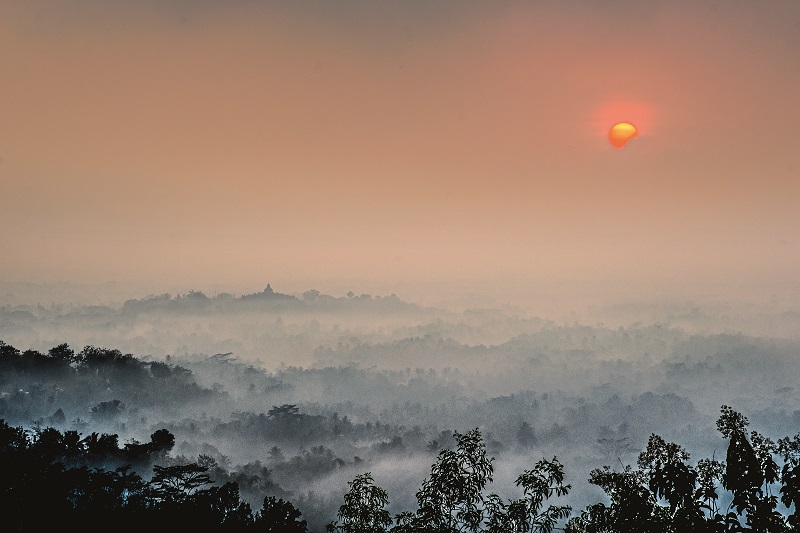
Temple Exploring
The magnificent Borobudur is the top draw in central Java, but there are other temples and palaces worth exploring, too. As Borobudur serves as an homage to Buddhism, the temple complex of Prambanan pays its tribute to Hinduism and its pantheon of gods. Built in the ninth century, Prambanan is the largest Hindu temple of ancient Java and has steadfastly endured until today, despite abandonment, unchecked jungle growth, several earthquakes and volcanic eruptions, and centuries of neglect.
Through all of this, Prambanan remains a site of stunning beauty. At 47m in height, the main shrine of the Prambanan complex is dedicated to the god Shiva, and two shrines of similar prominence (though only 33m in height each) are dedicated to the other two Hindu gods, Brahma and Vishnu.
Originally, there were some 240 temples in the Prambanan complex. Today, all eight of the main temples, as well as the eight smaller shrines in the interior zone, have been restored. However, of the 224 original small Pervara temples, only two have been fully reconstructed. The devastating earthquake that struck Jogja in May 2006 wrought considerable damage on the complex and toppled several of the shrines. Nevertheless, the grounds and temples are of great interest, particularly for those keen to learn more about the Hindu religion.
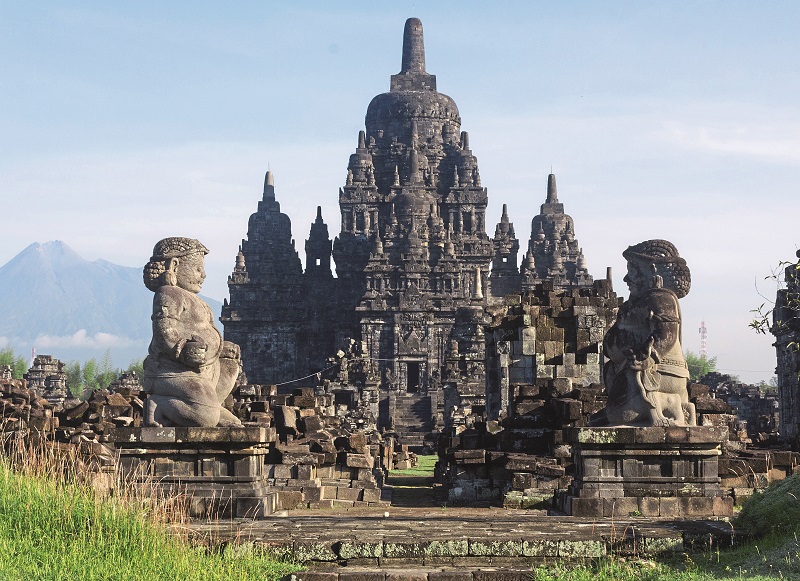
Though Prambanan is, for whatever reason, greatly overshadowed by Borobudur, for me, the former is generally a more enjoyable place to visit. It’s closer to Jogja, the grounds are large and park-like with numerous temples and sites of interest, and it’s almost always likely to be less crowded. Though Prambanan is a Hindu temple site, Indonesia’s second-largest Buddhist temple complex is just 800m north, located on the same grounds as Prambanan’s main temple area. Candi Sewu is an 8th-century Mahayana Buddhist temple, visually almost a blend of the styles of Prambanan and Borobudur, and is well worth the stroll from the main Hindu temples.
Borobudur and Prambanan understandably receive a substantial chunk of the attention, but there are plenty of other temples and palaces in the Jogja area that can be visited, too. With such evocative names as Sambisari, Kedulan, Gampingan, and Plaosan, these temples offer tourists a fine opportunity to learn about the architecture and designs of ancient cultures and to see the remnants of these once-splendid temples.
Another nearby archaeological gem is King Boko Palace, a hilltop retreat built over a thousand years ago as a place of spiritual reflection and peace. Called Ratu Boko, the villages and countryside surrounding the ruins are marvelously appealing, but admission to the site of the ruins is unfortunately priced high enough for foreigners to actually be a deterrent. A glance at the reviews for Ratu Boko on tripadvisor.com can help you decide for yourself whether or not this is worth your money. For updated ticket pricing to Borobudur, Prambanan, and Ratu Boko, visit borobudurpark.com.
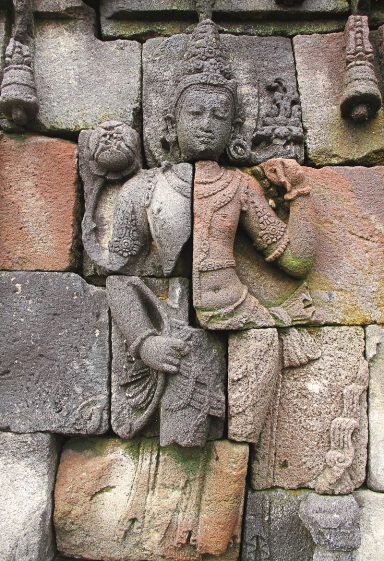
The city has flourished and endured in the shadow of Mount Merapi (“Mountain of Fire” in English), Indonesia’s most active volcano, a towering and impressive stratovolcano lying just 28km north of Jogja. The mountain, nearly 3,000 metres in elevation, frequently emits plumes of smoke and ash, and a number of violent eruptions have claimed lives, notably the series of November 2010 eruptions which ultimately killed 353 people and reduced the volcano’s elevation by 38 metres. The most recent eruption events occurred in late 2013 and again in March and April of 2014.
Despite the ever-present threat from Merapi, Jogja offers an inimitable charm, just one of the things that make this Central Javanese city such an appealing travel destination. It’s a delightful and inexpensive place to spend a few days, and you’ll come back with great memories to cherish. One of the best resources for all things Jogja is the occasionally mangled English-language website yogyes.com, the web’s top travel and tourism portal for the city.
This article was originally published in The Expat magazine (October 2016) which is available online or in print via a free subscription.
"ExpatGo welcomes and encourages comments, input, and divergent opinions. However, we kindly request that you use suitable language in your comments, and refrain from any sort of personal attack, hate speech, or disparaging rhetoric. Comments not in line with this are subject to removal from the site. "


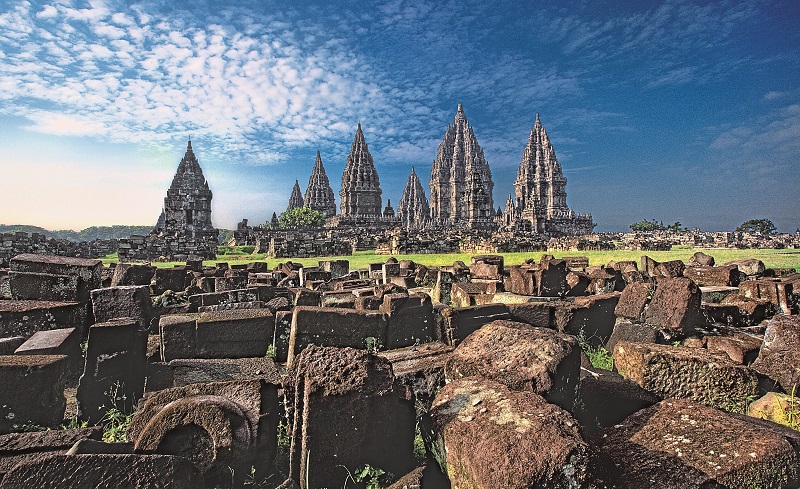
















Lamiae Skalli travel plans!
Que belleza!!
Awesome
Been there, beautiful indeed